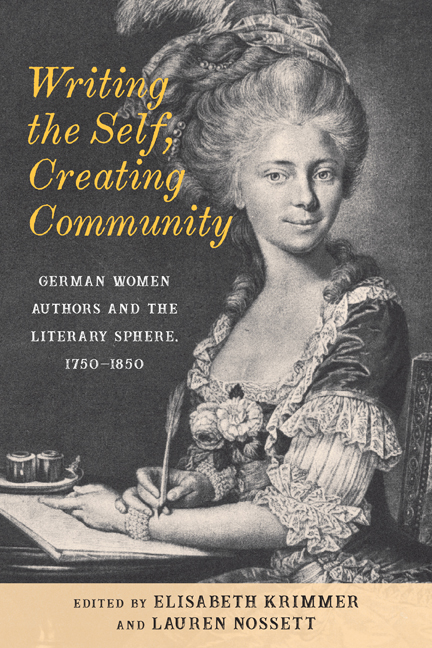Book contents
- Frontmatter
- Contents
- Acknowledgments
- Introduction
- Part I Writing a Community
- 1 Empowering Germany’s Daughters: On the Pedagogical Program and the Poetic Techniques of Sophie von La Roche
- 2 “Ich spreche lieber von guten Büchern”: Sophie von La Roche’s Concept of Female Authorship and Readership
- 3 Challenging Female Ideals: Marie-Elisabeth de La Fite’s Translation of Sophie von La Roche’s Geschichte des Fräuleins von Sternheim
- 4 Catherine II, Polyxene Büsching, and Johanna Charlotte Unzer: A Literary “Community of Practice”
- Part II Writing the Self
- 5 Ghostwriters: The Apparitional Author in Benedikte Naubert’s “Die Weiße Frau” (1792) and Sophie Albrecht’s Das Höfliche Gespenst (1797)
- 6 Vampirism Inverted: Pathology, Gender, and Authorship in Karoline von Günderrode’s “Die Bande der Liebe”
- 7 Wozu eine Amazonen—Literatur? Literary Creativity and Productivity in the Writings of Helmina von Chézy
- 8 Women Writers and the Märchenoma: Foremother, Identity, and Legacy
- Part III Writing toward Emancipation
- 9 The Illegitimacy of Authorship and the Legitimization of Passion in Agnes von Lilien
- 10 The Politics of the Female Body in Louise Aston’s and Fanny Lewald’s Writings through the Prism of the Romantic Theory of Sociability and Dialogue
- 11 Weibliche Irrsterne: Louise Otto and the Notion of Female Genius in Nineteenth-Century Germany
- Bibliography
- Notes on the Contributors
- Index
5 - Ghostwriters: The Apparitional Author in Benedikte Naubert’s “Die Weiße Frau” (1792) and Sophie Albrecht’s Das Höfliche Gespenst (1797)
Published online by Cambridge University Press: 01 October 2020
- Frontmatter
- Contents
- Acknowledgments
- Introduction
- Part I Writing a Community
- 1 Empowering Germany’s Daughters: On the Pedagogical Program and the Poetic Techniques of Sophie von La Roche
- 2 “Ich spreche lieber von guten Büchern”: Sophie von La Roche’s Concept of Female Authorship and Readership
- 3 Challenging Female Ideals: Marie-Elisabeth de La Fite’s Translation of Sophie von La Roche’s Geschichte des Fräuleins von Sternheim
- 4 Catherine II, Polyxene Büsching, and Johanna Charlotte Unzer: A Literary “Community of Practice”
- Part II Writing the Self
- 5 Ghostwriters: The Apparitional Author in Benedikte Naubert’s “Die Weiße Frau” (1792) and Sophie Albrecht’s Das Höfliche Gespenst (1797)
- 6 Vampirism Inverted: Pathology, Gender, and Authorship in Karoline von Günderrode’s “Die Bande der Liebe”
- 7 Wozu eine Amazonen—Literatur? Literary Creativity and Productivity in the Writings of Helmina von Chézy
- 8 Women Writers and the Märchenoma: Foremother, Identity, and Legacy
- Part III Writing toward Emancipation
- 9 The Illegitimacy of Authorship and the Legitimization of Passion in Agnes von Lilien
- 10 The Politics of the Female Body in Louise Aston’s and Fanny Lewald’s Writings through the Prism of the Romantic Theory of Sociability and Dialogue
- 11 Weibliche Irrsterne: Louise Otto and the Notion of Female Genius in Nineteenth-Century Germany
- Bibliography
- Notes on the Contributors
- Index
Summary
Ich [habe] für keiner Creatur in der Welt mehr Abscheu
…, als für einem gelehrten Frauenzimmer… .
[There is no creature in the world whom I abhor more than a learned woman]
TO MALE INTELLECTUALS of the late eighteenth century, an “overly educated” woman was an abomination. These women, among them female authors whose writing did not conform to the restrictive norms imposed on their gender, were described with a variety of pejorative terms that emphasized their unnaturalness. For Johann Wolfgang von Goethe, an intellectual woman was a “Männin” and “Amazone” (she-man and Amazon), for Johann Gottfried Herder an “Abscheu der Natur” (abomination of nature); while Adolph von Knigge claimed that the “ge lehrte Weiber” (educated women) moved him to feelings of “wenn nicht Ekel, so doch Mitleiden” (if not disgust, then certainly pity). Adjectives such as “abomination” and “disgust” and images such as that of the monstrous Amazon echo the language of gothic literature, in which monsters and horrific figures externalize cultural fears about shifting gender roles, among other things. In associating educated women in general and women authors in particular with “disgust” and “horror,” German intellectuals not only conceptualized them as threats to normative gender roles but transformed them into figures of horror.
The condemnation of women authors as unfeminine, monstrous, and unnatural by male intellectuals around 1800 has its roots in increasingly polarized notions of biologically based gender roles. Femininity was believed to be passive, receptive, and close to nature, while masculinity was characterized as active, assertive, and close to culture. Since femininity was associated with naturalness of thought and expression, it was vulnerable to corruption by too much education, or education in subjects deemed “unfeminine.” By the end of the eighteenth century, terminology emerged to differentiate between two types of educated women: the “gebildete Frau” versus the “gelehrte Frau.” While gebildete Frau referred to an appropriately well-rounded woman who remained true to her feminine nature, gelehrte Frau was transformed into a pejorative term applied to women whose education jeopardized their femininity. Male intellectuals also feared that the intellectual pursuits of the gelehrte Frau would divert time and energy from domestic responsibilities, causing instability in the domestic sphere.
- Type
- Chapter
- Information
- Writing the Self, Creating CommunityGerman Women Authors and the Literary Sphere, 1750–1850, pp. 116 - 137Publisher: Boydell & BrewerPrint publication year: 2020



